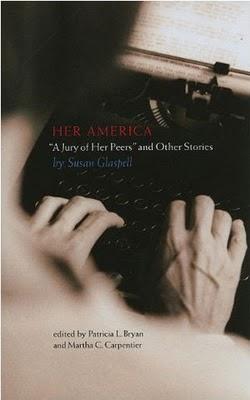Her America: “A Jury of Her Peers” and Other Stories

Popular in her own time, Susan Glaspell has somewhat fallen out of favor in contemporary academic circles while other American writers of realist fiction such as F. Scott Fitzgerald, Ernest Hemingway, and Willa Cather have enjoyed more attention. Yet, Glaspell enjoys a mini-renaissance in Her America: "A Jury of Her Peers" and Other Stories, an edited collection of twelve short stories that joins a growing movement led by feminist scholars to recuperate her work.
Spanning the years 1914 to 1927, these stories are vibrant tales of the United States at the turn of the century and are alternately humorous and touching, speaking to timeless concerns such as individual isolation, our collective responsibility to each other, the illusions we hold about ourselves and others, and the cost of pretending to be someone we’re not. Many readers will easily see themselves and/or their neighbors in Glaspell’s vivid cast of characters—whether it’s the young adopted woman who mourns the discovery that her biological mother was not a gypsy (“Unveiling Brenda”), or the pseudo-intellectual who feels sorry for his brother’s “common” life only to learn that his brother had, in fact, felt sorry for him (“Poor Ed”).
Glaspell’s compassion for the people who populate Her America is striking. This is clear in such stories as “The Manager of Crystal Sulphur Springs” wherein a caretaker chooses to let her elderly patient die rather than have him suffer potential humiliation or in the case of the farmer from the beautifully written “Pollen,” a man who obsessively isolates himself from his neighbors until he realizes that “I can’t have good corn while their corn’s poor.” Yet, even in stories wherein Glaspell pokes fun at her protagonists, she does so with an empathetic touch, reminiscent of Mark Twain’s satirical humor. A memorable instance is the story “Looking After Clara” about a vain man whose romantic overtures are undone by his beloved’s wily cat.
While it’s somewhat unfortunate that Glaspell is almost exclusively known for “A Jury of Her Peers” and the play Trifles on which it is based, it’s no wonder that this is the case. The story focuses on Mrs. Peters and Mrs. Hale who piece together a neighbor’s motive for killing her husband. While their husbands and the country attorney belittle their attention to Minnie Wright’s jarred preserves, quilt pieces and birdcage—what the men openly mock as “trifles”— these objects hold the key to her motive. These women come to realize Minnie’s desperation, and Mrs. Hale laments, “We live close together, and we live far apart,” questioning what was the greater crime—Minnie murdering her husband or her own failure to visit Minnie. Readers enjoy a pleasant surprise at encountering the story in its original version here. Between 1917 and its inclusion in The Best Short Stories of 1917 published in 1918, Glaspell made several revisions, most significantly deleting the final line, “He [the country attorney] did not see her [Mrs. Hale’s] eyes." Reprinting the original version opens up new interpretive possibilities for a classic of feminist literature.
Besides the stories, Her America opens with a very useful introduction by the editors Patricia L. Bryan and Martha C. Carpentier. It provides background information about Glaspell’s early career and publication history while also introducing the stories’ thematic concerns and summarizing key features of Glaspell’s style. Overall, this book is a welcome text in reviving interest in Glaspell’s shorter works, and its cast of characters should definitely be introduced to a new audience. Since this collection provides just a taste of Glaspell’s skill as a storyteller, one can only hope that a complete collection of her short stories is forthcoming soon.